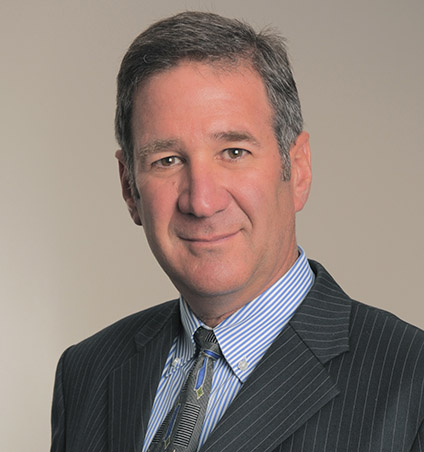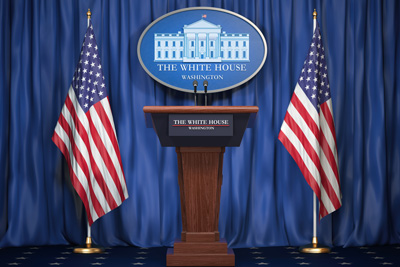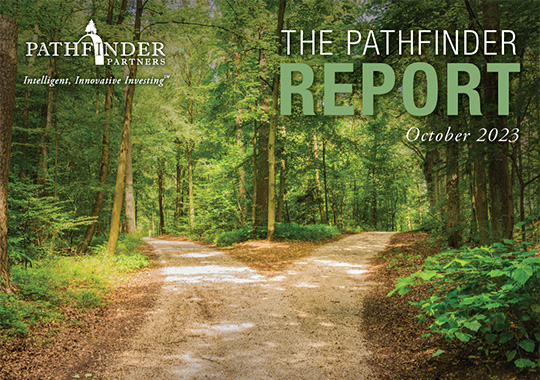Charting the Course
A Fork in the Road for the Fed
By Mitch Siegler, Senior Managing Director

The Federal Reserve has a conundrum. September’s Consumer Price Index (CPI) report, which showed that the annual inflation rate had risen to 3.7% in August from 3.2% in July presents the Fed with difficult choices. The path to the left (aka “the rock”) has the Fed moving the goalposts, backing off its longstanding 2.0% inflation target, settling for 2.5% or more. The path to the right (aka “the hard place”) has the Fed staying true to its pledge to stop at nothing to bring inflation under control. The Fed’s primary tool – higher interest rates – adds to the risk that excessive tightening tips the economy into a recession.
The Fed did not raise rates at its recent September meeting, which was widely expected. Futures markets peg the odds of a final 2023 rate hike in November at just under 50%. Many analysts believe the Fed is at or very near the end of its interest rate hikes. The case for inflation continuing to cool through year-end remains strong and we’ve avoided a recession so far. There’s more work to do to slay the inflation dragon and plenty that could still go wrong in this fight. Stated differently, markets could still face unpleasant surprises.
Fed governors have visibility on a gazillion economic data points. Fed policymakers are undoubtedly concerned that the increase in the annualized rate of inflation as measured by the CPI rose more than 10% in just one month (from 3.2% to 3.7%). They also observe that the Core PCE Index (aka Personal Consumption Expenditures Index, which strips out food and energy costs – because who buys those things anyway?) is running even hotter, up 4.3% over a year ago. Interest rate hikes always take time to ripple through the economy, which is why the Fed prefers a slow and steady approach. However, the Fed has played catch-up on inflation for the past 18 months and inflation running well above the Fed’s target rate will likely pressure Fed policymakers to “do more”.
Some good and not-so-good news.
 The Fed has made tremendous progress in beating back inflation, which is down dramatically from its 9.1% peak in June 2022. That said, progress has slowed this year and the current inflation level (3.7% or 4.3%, depending on your preferred measure) is still double the Fed’s 2.0% target. Understandably, this remains a serious concern for Fed policymakers and investors.
The Fed has made tremendous progress in beating back inflation, which is down dramatically from its 9.1% peak in June 2022. That said, progress has slowed this year and the current inflation level (3.7% or 4.3%, depending on your preferred measure) is still double the Fed’s 2.0% target. Understandably, this remains a serious concern for Fed policymakers and investors.
The consensus among analysts and pundits is that rates will likely remain “higher for longer”. Putting today’s rates in context, we’re at or near the top of the hill after climbing from sea level (0% Fed Funds rate) 18 months ago to 5.25% today. The CME Fedwatch tool, which we’ve written about previously, suggests even odds of an additional 0.25% rate hike this year with rates trending down in 2024. (The Fed’s median projection in June was four 25 basis point reductions in 2024 and that projection following the September meeting is for just one 25 basis point cut next year; there are 100 basis points in a percentage point.)
Below, we’ll unpack the current inflation situation but to say that there are lots of moving parts would be an understatement.
Shelter CPI accounted for 90% of the August CPI increase.
Shelter costs were up 7.7% in August compared with a year ago, which reflects a slowing of shelter inflation from the spring, when it peaked at 8.2%. Market indicators, like home prices and rents, have been softening for months and new apartment deliveries this year have led to concessions (four to eight weeks’ free rent) in many markets and substantially lower rent growth than in 2022. Additional apartment deliveries in 2024 and 2025 suggest continued softness in rents and cooling shelter inflation as we look ahead.
Renters have been the beneficiaries, but prospective homebuyers don’t have great options. With the average 30-year fixed mortgage rate knocking on the door of 7.0% (6.94% in August, per Zillow – above 7.25% at press-time), it’s challenging to buy a home. That crimps the market for first-time homebuyers and move-up buyers (why sell your current home with a 3% mortgage to “trade up” to a 7% mortgage?).
Gasoline CPI in August ran 10.6%.
 After returning from a four-day fact-finding trip in mid-September with several Pathfinder team members to Salt Lake City, Austin and San Antonio, I visited the gas station in California for the first time in two weeks. Sure, premium gas is more expensive but $6.17/gallon, really? The pump prices in Utah and Texas had a “$3” in front of them; that’s a conversation for another day. Gasoline prices nationally rose 10.6% in August (per the Bureau of Labor Statistics or BLS) but never fear, gas is excluded from the Core PCE data preferred by the Fed – and higher gas prices affect just the 98% of Americans whose cars are powered by internal combustion engines.
After returning from a four-day fact-finding trip in mid-September with several Pathfinder team members to Salt Lake City, Austin and San Antonio, I visited the gas station in California for the first time in two weeks. Sure, premium gas is more expensive but $6.17/gallon, really? The pump prices in Utah and Texas had a “$3” in front of them; that’s a conversation for another day. Gasoline prices nationally rose 10.6% in August (per the Bureau of Labor Statistics or BLS) but never fear, gas is excluded from the Core PCE data preferred by the Fed – and higher gas prices affect just the 98% of Americans whose cars are powered by internal combustion engines.
Wage inflation is a major concern.
There were 8.8 million open positions in the U.S. on August 1, according to the BLS. With an unemployment rate of just 3.8%, there aren’t enough idle workers to fill those jobs. Already, wage inflation, at 5.3%, is running 40% above the August CPI of 3.7% and a wage-price inflationary spiral is every economist’s (and politician’s) nightmare.
We’ve all heard stories about restaurants and hotels boosting wages to attract workers. Today, negotiating leverage seems to be squarely on the side of workers. We’re also hearing about more labor actions and strikes – at Starbucks, in Hollywood and with the Big Three automakers, among others. Hollywood writers and actors have been on strike for months fearful of the impact of artificial intelligence on their futures. Now, the United Auto Workers has initiated targeted strikes against GM, Ford and Stellantis (which owns Chrysler), seeking a 36% pay increase plus cost-of-living adjustments over four years, a 32-hour workweek with overtime, the restoration of retiree health benefits and defined benefit pensions instead of 401(k) plans. Nobody knows how this will end but pricier Big Three labor agreements are unlikely to position these companies to better compete against Tesla and non-union foreign companies like Toyota. As to inflation, higher new and used car prices are a virtual certainty.
The politics of a presidential election year could further pressure the Fed.
As inflation heated up in 2021, the Fed was slow to act, characterizing inflation as “transitory”. The Fed reversed course in January 2022 and has been on a quest since then to slay the inflation dragon. A series of 11 interest rate hikes have cooled the economy, particularly the stock market, housing market and corporate and consumer borrowing. Inflation has fallen more than 50% from its peak last summer, but it remains too high.
 n theory, the Fed is shielded from political pressure but that’s not always how things really work. The Fed’s near-term (and easier) decision is whether to hike rates by another 25 basis points this fall or just call it a day, leaving rates unchanged. The harder Fed decisions will be deciding how long to maintain rates at current levels, when to begin reducing rates and how quickly to let rates fall.
n theory, the Fed is shielded from political pressure but that’s not always how things really work. The Fed’s near-term (and easier) decision is whether to hike rates by another 25 basis points this fall or just call it a day, leaving rates unchanged. The harder Fed decisions will be deciding how long to maintain rates at current levels, when to begin reducing rates and how quickly to let rates fall.
With just over a year before the presidential election, the Fed’s already tricky balancing act – between tamping down inflation yet not tipping the economy into recession – is also colored by politics. It’s inevitable that the Fed will face mounting pressure to declare victory in its inflation fight, halt further increases and begin the process of easing rates. Nobody complains about a full punchbowl at a party, and many are unhappy when the Fed takes the punchbowl away. The problem with this – and sugar highs generally – is the longer-term cost of giving up the fight before the inflation battle is won could be extremely high.
Mitch Siegler is Senior Managing Director of Pathfinder Partners. Prior to co-founding Pathfinder in 2006, Mitch founded and served as CEO of several companies and was a partner with an investment banking and venture capital firm. He can be reached at msiegler@pathfinderfunds.com.
Share this Article
